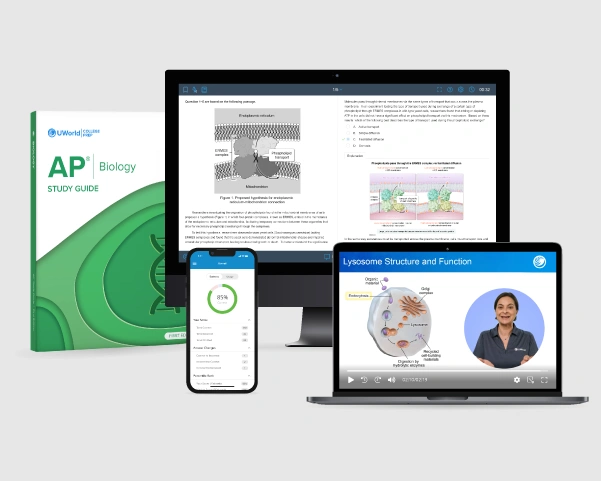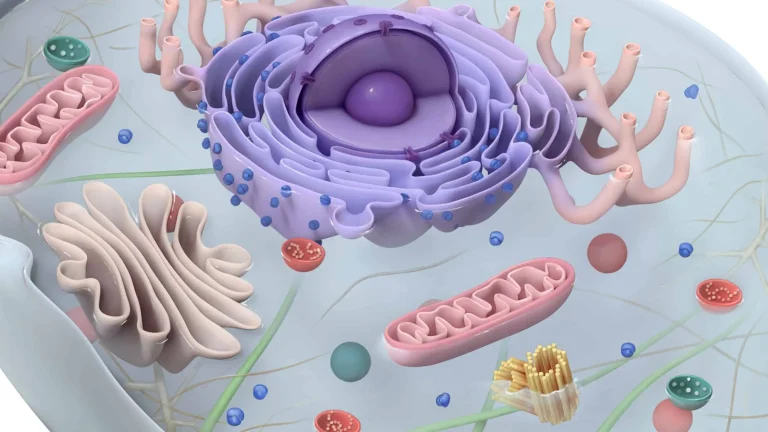AP Biology consists of 2 main sections — Science Practices and Course Content. Course content is divided into units, which are further broken down into topics. Each unit is based on 4 Big Ideas, which are biological concepts you need for a solid foundation in biology. The exam includes 60 multiple-choice questions (MCQs) and 6 free-response questions (FRQs) from these units, each with varying weights.
AP Biology Science Practices
Science Practices are essential skills that foster critical thinking and analysis. There are 6 practices you will master by the end of your AP Biology course.
| Science Practice | Concept Explanation |
|---|---|
| Concept Explanation |
|
| Visual Representations |
|
| Questions and Methods |
|
| Representing and Describing Data |
|
| Statistical Tests and Data Analysis |
|
| Argumentation |
|
AP Biology Course Content
The 8 AP Biology units are based on 4 Big Ideas. We will look at the Big Ideas first, then explain the individual units.
To enhance your understanding of these concepts, explore our AP Biology Study Guide, available in both print and digital formats, featuring 120+ end-of-topic Check for Understanding questions designed to solidify your knowledge.
4 Big Ideas in AP Biology Curriculum
Big Ideas are the themes explored throughout the curriculum. These AP Biology key concepts are interwoven throughout each of the course’s units because they apply in different ways.
Big Ideas
Big Idea 1: Evolution (EVO)
- The process that drives diversity and unity of life
- Change of gene frequencies in a population over time leading to biodiversity within and among species
- Charles Darwin's theory of natural selection explains how populations evolve through accumulating changes in their genes
- Environmental changes, natural catastrophes, and human-induced events alter gene pools, leading to further evolution
Units: Cell Structure and Function, Heredity, Natural Selection, and Ecology
Big Idea 2: Energetics (ENE)
- Biological systems depend on energy and molecules to grow, reproduce, and maintain homeostasis
- Living systems employ various methods to attain, use, and store energy
- Energy deficiencies can have detrimental effects on populations and ecosystems
Units: Chemistry of Life, Cell Structure and Function, Cellular Energetics, Cell Communication and Cell Cycle, and Ecology
Big Idea 3: Information Storage and Transmission (IST)
- Living systems store, retrieve, transmit, and respond to information essential to life processes
- Genetic information stored in DNA is passed from parent to offspring, influencing survival, growth, and reproduction
- Non-inheritable information influences behavior between cells, organisms, and populations, crucial for evolution and natural selection
Units: Chemistry of Life, Cell Communication and Cell Cycle, Heredity, Gene Expression and Regulation, and Ecology
Big Idea 4: Systems Interactions (SYI)
- Biological systems interact with each other exhibiting complex properties
- Interactions occur at molecular and ecosystem levels, enhancing diversity and resilience to environmental changes
Units: Chemistry of Life, Cell Communication and Cell Cycle, Cellular Energies, Heredity, Natural Selection, and Ecology

AP Biology Units and Their Topics
The course is divided into 8 units, each focusing on the 4 Big Ideas. Let’s take a look at each unit's weightage and AP Biology topics.
Unit 1: Chemistry of Life
8%-11% Exam Weighting | 5-7 Class Periods)
Unit 1 covers the chemical building blocks of life, focusing on elements for carbon-based systems and topics such as water significance, energy acquisition, and macromolecule exchange.
The Big Ideas explored in this unit:
- Big Idea 2: Energetics: The role of energy in the synthesis and breakdown of polymers
- Big Idea 3: Information Storage & Transmission: The transmission of information between living systems to ensure survival
- Big Idea 4: Systems Interactions: The importance of water’s polarity in living systems
Unit 2: Cell Structure and Function
(10%-13% Exam Weighting | 11-13 Class Periods)
Unit 2 dives into topics including the cell membrane, homeostasis, organelles, and cellular products and explores the connection between organelles and other cellular components.
The Big Ideas explored in this unit:
- Big Idea 1: Evolution: The eukaryotic cell’s origin
- Big Idea 2: Energetics: The advantages and disadvantages of cellular compartmentalization and the role of transport mechanisms involving the cell membrane in the conservation of energy
- Big Idea 4: Systems Interactions: The effect of the presence or absence of subcellular components on living systems
Unit 3: Cellular Energetics
(12%-16% Exam Weighting | 14-17 Class Periods)
Unit 3 explores how cells capture, store, and use energy through processes such as photosynthesis and cellular respiration.
The Big Ideas explored in this unit:
- Big Idea 1: Energetics: The accumulation and usage of energy by a living system
- Big Idea 4: Systems interactions: The usage or conservation of energy in relation to external stimuli
Unit 4: Cell Communication and Cell Cycle
(10%-15% Exam Weighting | 9-11 Class Periods)
Unit 4 covers cell communication, transduction pathways, and energy utilization for growth and replication.
The Big Ideas explored in this unit:
- Big Idea 2: Energetics: How cells use energy to communicate with each other
- Big Idea 3: Information storage and transformation: How the cell cycle helps with the retention of genetic information and why cells communicate with each other
Unit 5: Heredity
(8%-11% Exam Weighting | 9-11 Class Periods)
Unit 5 explores the topic of heredity, specifically focusing on the biological concepts and processes involved.
The Big Ideas explored in this unit:
- Big Idea 1: Evolution: The influence of genetics on our understanding of evolution
- Big Idea 3: Information Storage and Transmission: The importance of characteristics suppression from one generation to the next and arguing Mendel’s laws
- Big Idea 4: Systems Interactions: Influence of the diversity of a species on inheritance
Unit 6: Gene Expression and Regulation
(12%-16% Exam Weighting | 18-21 Class Periods)
Unit 6 explores the role of nucleic acids in gene expression and investigates the structural differences between DNA and RNA.
The Big Idea explored in this unit:
- Big Idea 3: Information Storage and Transmission: The relationship between gene regulation and the continuity of life and the diversification of genetic information from one generation to the next
Unit 7: Natural Selection
(13%-20% Exam Weighting | 20-23 Class Periods)
Unit 7 delves into the concept of natural selection and its role in driving evolution. The main focus is on how populations adapt to their environments to ensure survival and successful reproduction.
The Big Ideas explored in this unit:
- Big Idea 1: Evolution: Defend the theory of evolution in scientific terms and discuss the conditions that could possibly make a population less or more likely to evolve
- Big Idea 4: Systems Interactions: Identify how species interactions can hamper or encourage evolution
Unit 8: Ecology
(10%-15% Exam Weighting | 18-21 Class Periods)
Unit 8 examines ecology, with a focus on the interconnections among biological systems.
The Big Ideas explored in this unit:
- Big Idea 1: Evolution: Biodiversity is essential to the survival and evolution of the species within that ecosystem
- Big Idea 2: Energetics: The relationship between energy and a biological system's health
- Big Idea 3: Information Storage and Transmission: The effect of disruptions in a biological system on the storage and transmission of genetic information
- Big Idea 4: Systems Interactions: The effect of interactions among species on the survival of an ecosystem
Each of these AP Biology units and topics will help you establish a solid and comprehensive understanding of the subject, preparing you for success on the AP Bio exam. Get a sense of how you might be tested on these with our AP Biology practice tests. You can customize each test by selecting the units you want questions from and choose the number of questions you’d like. You’ll get detailed and illustrated answer explanations for each question, plus the ability to create flashcards using spaced repetition.
AP Biology Labs: An Outline
Lab experiments are part of the AP Biology CED. Labs allow you to create scientific questions, perform experiments, and delve into course subjects. Thirteen labs covering ideas such as artificial selection, diffusion, osmosis, and cellular processes improve your scientific reasoning and analysis skills. They also will help you:
- Master the subject matter
- Understand the empirical work
- Develop practical skills
- Learn the nature of science
- Drive your interest in scientific learning
- Develop your teamwork skills
As part of your labs, you will need to ask questions, design experiments to test your hypotheses, conduct experiments, analyze your findings, and reach conclusive results. To enhance your understanding and prepare effectively, explore our AP Bio review course, which offers detailed explanations and practice tools tailored to AP Biology topics.

Frequently Asked Questions (FAQs)
What are the most important topics in AP Biology?
Here is a list of the most important AP Biology topics based on their exam weighting:
- Unit 7: Natural Selection (13%-20%)
- Unit 3: Cellular Energetics (12%-16%)
- Unit 6: Gene Expression and Regulation (12%-16%)
- Unit 4: Cell Communication and Cell Cycle (10%-15%)
- Unit 8: Ecology (10%-15%)
- Unit 2: Cell Structure and Function (10%-13%)
- Unit 1: Chemistry of Life (8%-11%)
- Unit 5: Heredity (8%-11%)
Can I take AP Biology without taking regular biology?
No. Taking high school biology is a prerequisite for taking AP Biology.
Is AP Biology an easy subject?
References
- (2024). Science Practices. AP Biology. AP Central Retrieved January 02, 2025 from https://apcentral.collegeboard.org/courses/ap-biology
- (2020). Big Ideas. Course Content. AP Central Retrieved January 02, 2025 from https://apcentral.collegeboard.org/media/pdf/ap-biology-course-and-exam-description.pdf
- (2024). Course Content. AP Biology. AP Central Retrieved January 02, 2025 from https://apcentral.collegeboard.org/courses/ap-biology
Learn More About Specific AP Biology Units
Strengthen your grasp of AP Biology by exploring related units that build on these concepts.
Read more about AP Biology
A comprehensive guide offering expert tips and detailed guidance on how to effectively study and excel in AP Biology using the right course materials and strategies.
AP Biology Exam FormatGain a deep understanding of the AP Biology exam with our comprehensive guide that explains the format, question types, and essential details to prepare effectively.
AP Biology Score GuideExplore how the AP Bio exam is scored, detailed score distributions, what average score qualifies for college credit, and tips to help you achieve your target score.
How to Self-Study for AP BiologyWant to ace AP Biology on your own? Follow this expert self-study guide with tips, tricks, and tools to prepare effectively for the exam.
Best AP Biology Prep Course ReviewSearching for top AP Biology prep courses? Read this review to compare the best courses and choose the perfect one for your success.
Best AP Biology Study Guide ComparisonExplore top AP Biology study guides to find the best resources for the exam. Compare features, pros, cons, and reviews to select the perfect guide for success.




